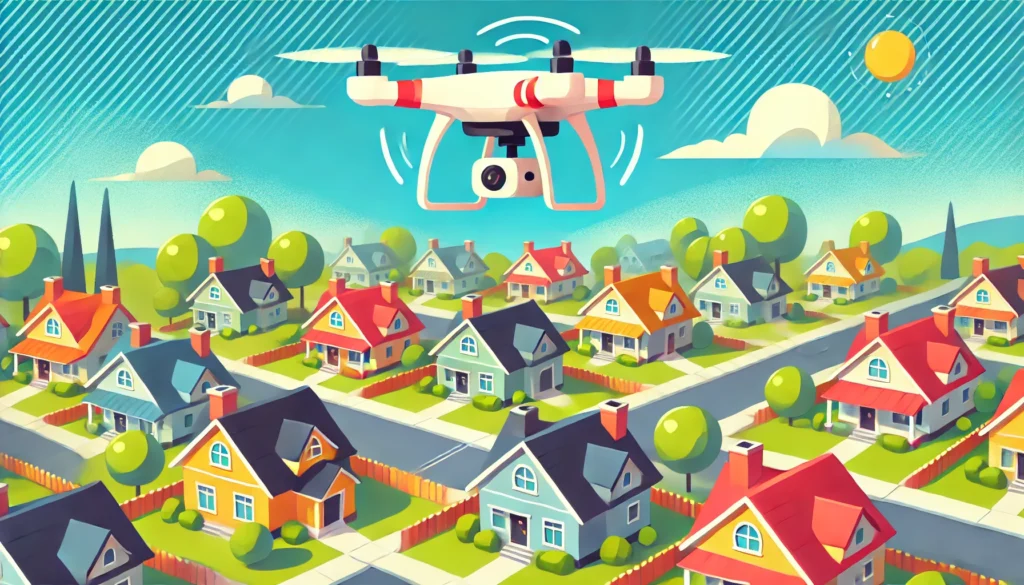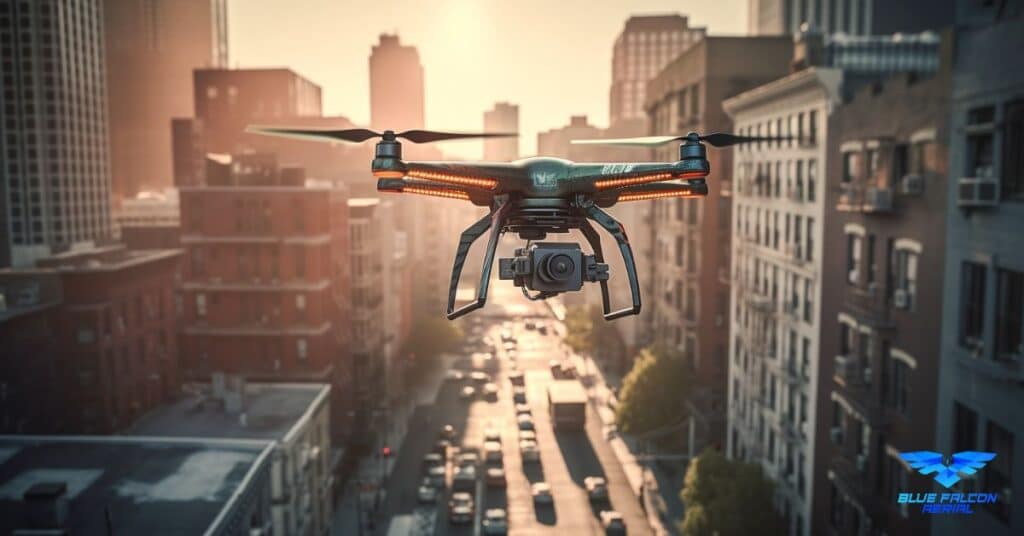In the fast-paced world of urban development, Orthomosaic for Urban Growth Analysis is emerging as a revolutionary tool. Assembled from a multitude of high-resolution aerial images, Orthomosaic maps offer unparalleled precision and detail. These exhaustive perspectives of the urban landscape are driving strategic decision-making and efficient urban planning. Whether it’s measuring urban growth, predicting future patterns, or enhancing sustainability, Orthomosaic technology is playing a crucial role in reshaping our urban world.
Understanding Orthomosaic
Orthomosaic, a term derived from ‘Ortho’, meaning ‘correct’, and ‘Mosaic’, signifying a combination of multiple entities, is a large, highly detailed, and geometrically accurate image. Constructed by stitching together hundreds or even thousands of aerial photos, an orthomosaic map presents a comprehensive and accurate view of the surveyed area, devoid of the perspective distortion typically found in oblique images.
What is an Orthomosaic?
Orthomosaic maps are a type of digital elevation model used in photogrammetry, a technique that measures distances using photographs. They hold a significant edge over conventional aerial photos due to their high degree of accuracy and detail. Orthomosaics can accurately represent the Earth’s surface, including both natural and man-made features, making them a valuable tool in numerous applications such as surveying, agriculture, and, of course, urban planning.
An orthomosaic image can be defined as a georeferenced image product mosaicked from several aerial photographs, where the distortions caused by camera optics and different flight altitudes have been corrected. In simpler terms, it’s a large, detailed, and corrected aerial photo composed of many smaller photos.
How is Orthomosaic Created?
Creating an orthomosaic map involves several steps, which can be summarized as follows:
Aerial Photograph Capture: High-resolution aerial photographs of the area of interest are captured using drones or other aerial vehicles.
Image Processing: The captured images are processed and adjusted to ensure that they are free from any distortions.
Image Stitching: The corrected images are then stitched together using advanced software to create a single, seamless orthomosaic map.
Different Uses of Orthomosaic
Orthomosaic maps are used across various industries and fields, given their high degree of accuracy and detail. Here are some of the most common applications:
Surveying and Mapping: Orthomosaics are widely used in surveying and mapping for creating detailed and accurate maps of an area.
Urban Planning: They are used in urban growth analysis to understand, plan, and manage urban development efficiently.
Agriculture: Orthomosaics help in precision agriculture by providing detailed information about crop health, yield prediction, and more.
Environment and Conservation: They aid in studying and monitoring environmental changes, wildlife habitats, and more.
Orthomosaic and Urban Planning
Urban planning and development require accurate and detailed data. The rapid advancements in technology, especially the integration of Orthomosaic mapping with drone technology, have substantially augmented the scope and efficiency of urban planning.
Role of Orthomosaic in Urban Planning
Orthomosaic maps provide a detailed and precise overview of the landscape, making them an invaluable tool in urban planning. They offer a comprehensive understanding of land use, topography, and other significant parameters, enabling urban planners to make informed decisions.
The application of Orthomosaic maps in urban planning ranges from infrastructure development, site analysis, land use planning, to zoning and other developmental projects. With an accurate and detailed orthomosaic map, planners can analyze current urban layouts, identify potential areas for development or improvement, and efficiently design future urban growth patterns.
Urban Growth Analysis Using Orthomosaic
With Orthomosaic maps, urban growth analysis has been revolutionized. Planners now have access to a high-resolution, bird’s-eye view of urban landscapes. This allows for the identification of patterns and trends in urban growth, informing strategic planning and developmental efforts.
Orthomosaic maps also provide quantitative data, enabling precise measurement of land use, vegetation coverage, built-up areas, and more. This facilitates the monitoring of urban growth over time and helps predict future urban expansion patterns.
Techniques for Studying Urban Development with Orthomosaic
Orthomosaic is much more than just a simple map – it’s a wealth of detailed data that can be mined for valuable insights. When it comes to studying urban development, several key techniques stand out:
Land Use Classification: By distinguishing between different types of land use (residential, commercial, green space, etc.), urban planners can better understand the structure of a city and how it’s changing over time.
Change Detection: Comparing orthomosaic maps from different time periods can highlight areas of rapid development or decline. This allows planners to identify trends and intervene if necessary.
Infrastructure Planning: Detailed orthomosaic maps can guide the placement of new infrastructure, such as roads, utilities, and public transit routes. This ensures that all areas of a city are adequately served.
Environmental Impact Assessment: Orthomosaic maps can also be used to assess the environmental impact of urban growth. For example, they can help quantify the loss of green space due to development, or identify areas at risk of flooding.
Spatial Analysis: This involves the study of spatial relationships between different urban elements. For instance, one might investigate the correlation between population density and proximity to public transit, or the impact of green space on property values.
Spatial Analysis of Urban Growth Patterns
Spatial analysis is a vital tool in urban planning, and orthomosaic maps provide the perfect canvas on which to perform this analysis. By highlighting patterns and relationships that might otherwise be overlooked, spatial analysis can lead to more sustainable and equitable urban development.
For example, spatial analysis can reveal areas of a city that are underserved by public transit, or neighborhoods that are experiencing particularly rapid gentrification. It can also help urban planners anticipate future growth patterns, so they can proactively plan for necessary infrastructure and services.
Orthomosaic maps can also aid in the visualization of spatial data, making it easier to understand and communicate. For instance, a color-coded orthomosaic map might show population density, land use, or income levels at a glance.
In essence, the integration of Orthomosaic technology with spatial analysis enables urban planners to derive profound insights into urban growth patterns, aiding the formulation of data-driven, efficient strategies for sustainable urban development.
Benefits and Accuracy of Orthomosaic for Urban Growth Analysis
Orthomosaic maps are reshaping the way we view and interact with our urban landscapes. But what exactly makes them such a powerful tool for urban growth analysis? Let’s delve into the benefits of Orthomosaic technology and explore its accuracy.
Precision and Accuracy of Orthomosaic
One of the primary benefits of Orthomosaic maps is their high degree of precision and accuracy. Each pixel in an orthomosaic map corresponds to a specific location on the ground, providing a real-world scale that is consistent throughout the entire image.
The accuracy of an Orthomosaic map depends on several factors, including the quality of the images, the altitude at which they were taken, and the software used to stitch them together. Nevertheless, under ideal conditions, orthomosaic maps can achieve a spatial resolution of up to 1 cm per pixel. This high level of detail enables precise measurements of distances, areas, and volumes, which are essential for effective urban growth analysis.
Comprehensive Perspective
Unlike regular aerial photographs, which offer a perspective view, orthomosaic maps provide a top-down, or “orthographic,” view. This eliminates the perspective distortion present in oblique images, offering a truly comprehensive perspective of the landscape. The comprehensive view provided by orthomosaic maps allows urban planners to have a better understanding and visualization of the terrain, which is crucial in effective planning and decision-making.
Impact of Orthomosaic Analysis on Urban Planning
Orthomosaic analysis has a profound impact on urban planning. It facilitates a more detailed understanding of the urban environment, enabling the identification of trends, measurement of growth, and planning for future developments.
With orthomosaic maps, planners can analyze and measure elements such as built-up areas, vegetation, water bodies, and other urban features. This information aids in the development of strategic urban growth plans, infrastructure design, and zoning regulations.
Integration of Orthomosaic Data in Urban Development Projects
The integration of orthomosaic data in urban development projects is another significant benefit of this technology. With the detailed and accurate data provided by orthomosaic maps, urban planners can make more informed decisions about where and how to implement development projects. This leads to more efficient resource allocation and better project outcomes.
Moreover, orthomosaic data can be easily integrated with other geospatial data, such as LiDAR and GIS data, providing a more comprehensive understanding of the urban environment.
Software and Tools for Orthomosaic Data Analysis
There’s an impressive array of software and tools available that can turn raw drone imagery into comprehensive orthomosaic maps, and then help analyze these maps for urban growth patterns.
Commonly Used Tools
DroneDeploy: This cloud-based software provides tools for creating and analyzing orthomosaic maps. It offers features such as 3D modeling, volumetric calculations, and change detection.
Pix4D: An industry-leading software suite for drone mapping, Pix4D offers advanced photogrammetry tools for creating, viewing, and analyzing orthomosaic maps.
Agisoft Metashape: This software offers a complete suite of photogrammetry tools, including orthomosaic, 3D modeling, and more.
ArcGIS Pro: An integral part of the ESRI GIS ecosystem, ArcGIS Pro provides powerful tools for analyzing orthomosaic maps and integrating them with other geospatial data.
These tools not only facilitate the creation of accurate orthomosaic maps but also provide advanced analysis capabilities that make urban growth analysis more efficient and effective. The adoption and integration of these tools in the urban planning process significantly enhance the ability to understand and manage urban growth.
Challenges and Limitations of Using Orthomosaic in Urban Planning
As impactful as orthomosaic technology is in the realm of urban planning, it is important to note that it is not without its challenges and limitations. These issues range from technical considerations to practical constraints.
Possible Issues and Their Solutions
There are various challenges associated with the use of orthomosaic in urban planning. Some of these include the time and computing power required for image processing, ensuring image quality and accuracy, and managing and interpreting the voluminous data produced. Here is a brief look at these challenges and their potential solutions:
Time and Computing Power for Image Processing: The process of transforming drone-captured images into a cohesive orthomosaic map is computation-heavy and can take a considerable amount of time. This issue can be mitigated by utilizing cloud-based processing solutions, such as those provided by DroneDeploy and Pix4D.
Ensuring Image Quality and Accuracy: The final quality and accuracy of the orthomosaic map can be affected by various factors, including the quality of the drone’s camera, the altitude at which images were captured, and the image processing techniques used. Using high-quality drone cameras, proper flight planning, and advanced image processing software can ensure the production of precise and accurate maps.
Data Management and Interpretation: Managing, storing, and interpreting the large amount of data generated by orthomosaic maps can be challenging. The use of robust GIS and data analysis tools, along with the expertise of trained personnel, can enable effective interpretation and utilization of this data.
Addressing Challenges in Urban Planning with Orthomosaic Insights
Despite the potential challenges, the insights derived from orthomosaic mapping can address numerous urban planning challenges:
Mitigating Urban Sprawl: Orthomosaic mapping helps identify land use changes and growth patterns that lead to urban sprawl, thereby helping implement measures to control and promote sustainable development.
Enhancing Infrastructure Planning: Orthomosaic maps enable more informed decision-making in terms of infrastructure placement and development.
Promoting Environmental Sustainability: Detailed data on natural features and green spaces within the urban environment can help design cities that balance development and environmental preservation.
Orthomosaic Analysis: Future Predictions and Sustainability
Orthomosaic technology holds promise for not just interpreting the present state of urban landscapes but also predicting future urban growth patterns and enhancing sustainability.
Predicting Future Urban Growth Using Orthomosaic Data
The data provided by orthomosaic maps can feed into predictive models for urban growth. Analysis of past and present patterns of land use, infrastructure development, and population growth allows these models to estimate future urban expansion and growth patterns.
Enhancing Sustainability Through Orthomosaic-guided Urban Design
Orthomosaic technology can also contribute significantly to sustainability in urban design. The data-driven planning and decision-making facilitated by orthomosaic technology can shape sustainable cities of the future, optimizing land use, promoting green urbanism, ensuring equity in urban development, and designing for climate resilience.
Case Studies of Orthomosaic Application
To illustrate the practical application of orthomosaic technology in urban planning, let’s examine a few case studies:
Case Study 1: Measuring Urban Growth with Orthomosaic Analysis
In one city, urban growth was monitored using orthomosaic mapping. The highly detailed maps provided a comprehensive view of urban sprawl and changes in land use over time. This data informed the city’s urban growth plan and facilitated proactive, sustainable planning.
Case Study 2: Using Orthomosaic Technology for Urban Development Assessment
In another instance, orthomosaic maps were used to assess the impact of an urban development project. The before-and-after maps allowed planners to visualize the project’s impact on the local environment and infrastructure, ensuring that the development was in line with the city’s sustainability goals.
Orthomosaic Analysis with Blue Falcon Aerial
At Blue Falcon Aerial, we leverage orthomosaic technology to provide valuable insights for urban planning and development. Our sophisticated drones, coupled with advanced image processing software, deliver highly accurate orthomosaic maps that empower urban planners to make data-driven decisions. With our services, we aim to contribute to sustainable, resilient, and equitable urban growth. Whether you need to monitor current urban growth or predict future patterns, our orthomosaic services are at your disposal.
Orthomosaic for Urban Growth Analysis is indeed a game-changer in urban planning and development. With unmatched precision and comprehensive view, it aids in assessing, predicting, and planning urban growth patterns in a sustainable way. Whether overcoming challenges in urban planning or integrating data in urban development projects, the potential of Orthomosaic is vast and promising. For a more comprehensive understanding of Orthomosaic and its application, we recommend you visit our Ultimate Guide to Drone Photogrammetry and Orthomosaics.
If you’re looking for expert drone services or wish to explore more about Orthomosaic analysis, do not hesitate to reach out to us at Blue Falcon Aerial. Let’s navigate the future of urban development together, with the power of Orthomosaic.




